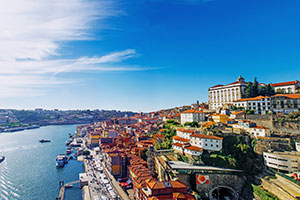Globus
Experience the best of Portugal and take in the important cities of Lisbon and Porto, typical towns and villages, and the stunning north-west coastline. Throughout this tour, you’ll visit the must-see attractions, including the 16th-century Jeronimos Monastery. Often regarded as Lisbon’s most important landmark, it was traditional for Portuguese seafarers to pray in the chapel before their departure to the unknown.
You’ll visit the Sanctuary of our Lady of the Rosary in Fátima, a pilgrimage site where apparitions of the Virgin Mary were reported by three local children in 1917; the 700-year-old university in Coimbra; the Arabian Hall in the Stock Exchange in Porto, and the Ossuary Chapel in Evora, with its bone- and skull-covered walls. For this exceptional escorted tour of Portugal, Globus has arranged some special treats so that you can savor Portuguese cuisine and wine. Enjoy a port wine tasting at one of the local wine cellars in Porto, an olive oil tasting in Belmonte (birthplace of Pedro Alvares Cabral, discoverer of Brazil), and petiscos with wine at the Quinta da Aveleda winery. All of this and much more awaits you on this wonderful Portuguese Escape!
Featured Destinations
|
Viseu
|
|
Porto (Oporto)
Porto (Oporto)
Porto (Oporto), Portugal's second largest city, is full of interest, and the district it heads offers the visitor plenty to see. Along the coast, there are resorts like the cosmopolitan beach of Espinho, busy ports like Matosinhos, with splendid seafood, or traditional fishing towns like Póvoa de Varzim, and there is also an animated casino. Charming Amarante has 17th century mansions overlooking the river and is famous for a sweet egg pastries called "papos de anjo" (angel bellies). In Vila Nova de Gaia, there are lodges where Port wine is blended and aged and where tasting are offered, or visitors may take a river cruise along the Douro. The whole district is filled with prosperous towns, but there are also many calm roads with wonderful views over the river and a rugged and still unspoilt coastline.
|
Destination Guide
|
Tomar
Tomar
The hillside centerpiece of the small town of Tomar, Portugal, is the 12th-century castle built by the crusading Order of the Knights Templar and the later monastery built around it. The entire complex is listed as a UNESCO World Heritage site. The Charola, a 16-sided structure surrounding a gilt octagon, served as the knights' oratory. Several cloisters were added to the complex at different stages, most of them reflecting the power and prestige of the Order of Christ (successor to the Knights Templar order) and its role during the age of exploration. Also worth seeing in Tomar is one of the oldest synagogues in Portugal, dating back to 1430 but last used as a place of worship in 1496, when the Jews were expelled from the country by Manuel I. It now houses a small Jewish museum. On a lighter note, the largest collection of matchboxes in Europe can be seen at the Museu dos Fosforos.
|
Destination Guide
|
Lisbon
Lisbon
Portugal’s capital is an 18th-century city - elegant, open to the sea and carefully planned. Most places of interest are within easy walking distance. Rossio Square, the heart of Lisbon since medieval times, is an ideal place to start exploring. Many rebuilt houses with original façades provide stores and restaurants with modern interiors. High above Baixa is Bairro Alto - with its teeming nightlife. There are many monuments and museums, such as San Jeronimos Monastery, Royal Coach Museum and Gulbenkian Museum. Two well-known landmarks are the Monument to the Discoveries and the Tower of Belem. A statue of Christ looms above Europe’s longest suspension bridge. Madragoa, Bica and Bairro Alto, Lisbon’s older sections, offer a variety of sights: the Church of Sao Roque, with its beautiful tiles; St. George Castle, which offers a splendid view from its location above the Alfama quarter; the botanical gardens, featuring an unusual, cold greenhouse; and the cathedral, stunning with its Moorish design. Renowned Gulbenkian Museum is the cultural center of Portugal.
|
Destination Guide
|
Evora
Evora
Evora is considered a seat of learning with its University founded in 16th Century by Cardinal Dom Henrique. Within the surrounding wall the most prominent feature is the 2nd or 3rd Century ruins of a Roman Temple dedicated to Goddess Diana. Another attractive feature is the 15th Century Convento dos Lóios. The city’s 13th century cathedral took 50 years to build and is reminiscent of a fortress. The main square with its 16th Century fountain has a sad history. Among other events, Dom João II witnessed the beheading by his orders of his brother-in-law. Equally unpleasant were the sights caused by the Inquisition in this public place. A macabre reminder is the Capela dos Ossos in the 15th Century Igreja de São Francisco - where the bones of 5,000 monks lie. There are several museums - the Museu de Arte Sacra, Galeria de Arte Casa Cadaval, the Museu de Artes Decorativas Religiosas and the Museu de Évora. The museum, formerly the palace of the Bishop, built with many worked stones from previous buildings in the city, has some outstanding religious items.
|
Destination Guide
|
View Full Itinerary
Valid Date Ranges
-
February 2025
| 02/01/2025 |
02/09/2025 |
$1,499 per person
|
| 02/08/2025 |
02/16/2025 |
$1,699 per person
|
-
March 2025
| 03/13/2025 |
03/21/2025 |
$1,899 per person
|
| 03/15/2025 |
03/23/2025 |
$1,899 per person
|






